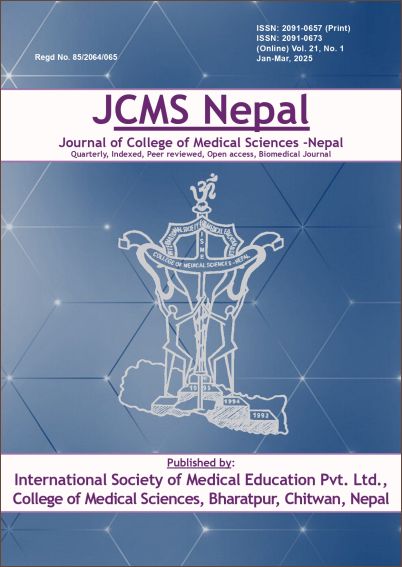Prevalence of Dental Caries and Associated Factors among Patients Visiting a Tertiary Care Teaching Hospital in Madhesh Province, Nepal: A Cross-Sectional Study
DOI:
https://doi.org/10.3126/jcmsn.v21i1.69771Keywords:
dental caries, prevalence, DMFT, NepalAbstract
Background
Globally, dental caries is the most common oral health issue and a major public health problem. The prevalence of dental caries in a population is influenced by a number of risk factor such as gender, socioeconomic status, dietary patterns and oral hygiene habits. The aim of this study was to determine the prevalence of dental caries and associated factors among patients who visited the tertiary care teaching hospital in Madhesh Province, Nepal.
Methods
An analytical cross-sectional study was conducted among patients who visited the dental Outpatient Department in a tertiary care teaching hospital. Data collection was done from 6th April 2024 to 31st August 2024 after taking ethical approval from the Institutional Review Committee. Patients above 18 years visiting the dental OPD of a teaching hospital, and who had provided informed consent were enrolled in the study. Convenience sampling was done. A pretested standardized, close-ended questionnaire was distributed by researchers to gather information regarding the associated factors and oral hygiene practices. Clinical examination was performed for dental caries according to the criteria given by the World Health Organization (WHO) using the “DMFT” index.
Results
The overall prevalence of dental caries was 69.9%. Mean DMFT score was 2.91±3.34. No statistically significant association was found between caries prevalence and gender (p = 0.05). There was statistically significant association of caries prevalence with socio-economic status (p = 0.02), brushing status (p < 0.001), use of fluoride toothpaste (p < 0.001) and consumption of sugar foods before bed (p < 0.001).
Conclusions
The prevalence of dental caries among the study participants was high. Factors associated with dental caries included poor oral hygiene practice, consuming sugar foods before bed and between the meals.
Downloads
Downloads
Published
How to Cite
Issue
Section
License
Copyright (c) 2025 The Author(s)

This work is licensed under a Creative Commons Attribution-NonCommercial-NoDerivatives 4.0 International License.
This license enables reusers to copy and distribute the material in any medium or format in unadapted form only, for noncommercial purposes only, and only so long as attribution is given to the creator.




